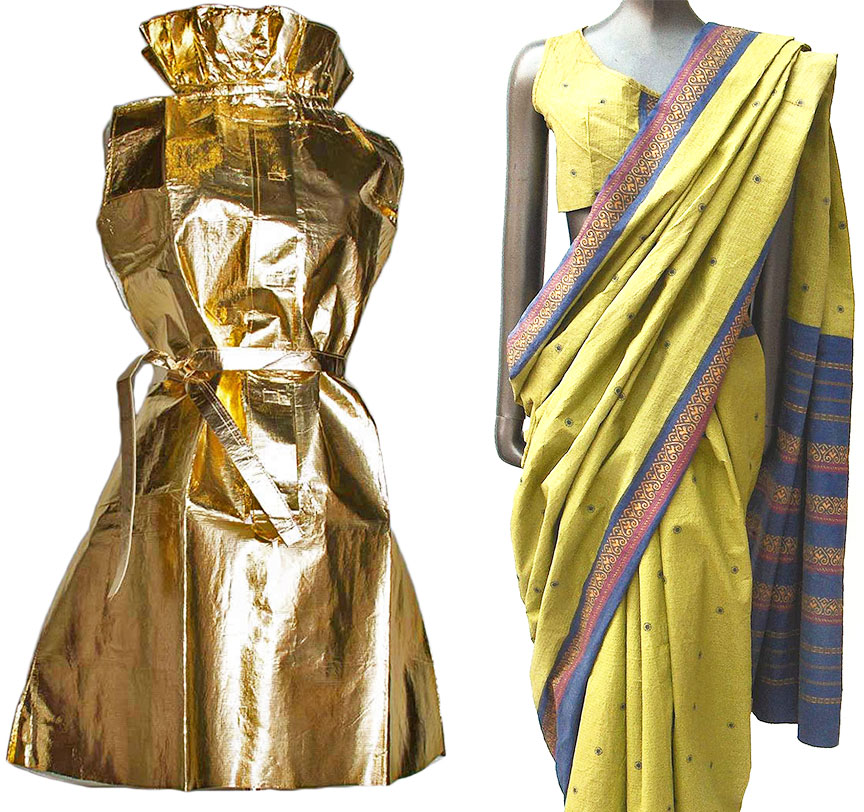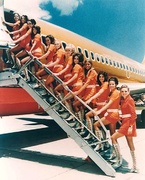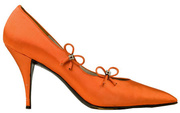
Like many great things, it all started with toilet paper: In the spring of 1966, the Scott Paper Company, a major manufacturer of disposable household paper goods, launched a promotion for its colorful new line of bathroom tissue, napkins, paper towels, and other products. Along with a couple of proofs-of-purchase, customers could redeem a mail-order coupon for a preposterous new concept, a paper dress. The advertisements offered two designs, a red paisley bandana pattern or a black-and-white Op Art print, both at the low price of $1.25 including shipping.
“They went out of fashion for quite a few different reasons, but durability wasn’t really the problem.”
While wearable items had been made from paper in the past—think paper folding fans, crepe paper costumes, or paper soda-jerk hats—they’d never truly caught on as mainstream fashion. But Scott’s “Paper Caper” dresses were a surprise hit, and by the year’s end, the company had received nearly half a million orders. Several other businesses jumped on the disposable clothing bandwagon, as hip young women clamored for the cheap paper shifts advertising their favorite political candidates or candy bars, or featuring groovy patterns and modern photography. Yet like these disposable garments, the trend was also short-lived; by the end of the Go-Go Sixties, the fad was already passé.
Before the paper dress became a phenomenon, fabric made from plant cellulose was conceived as a cheap alternative to reusable woven textiles in places like hospitals and laboratories. When reinforced cellulose was developed during the late 1950s, companies were afraid to market the materials using the term “paper” because they feared their products would be seen as too weak. Scott’s product consisted of a rayon scrim in between two layers of cellulose fiber, which it named Duraweave, while competitor Kimberly-Stevens called their cellulose-and-nylon combo Kaycel. “They thought it’d be good for hospital gowns, radiation suits, that kind of thing,” explains Jonathan Walford, curatorial director of the Fashion History Museum in Cambridge, Ontario. “They hadn’t even thought about fashion as a possibility.”

Top: The first paper dresses featured in Scott’s promotional ads from 1966. Above: A “Life” magazine photo of hand-painted dresses designed by Tzaimus Luksus for the Wadsworth Atheneum paper ball in 1966.
Then, in 1965, an engineer for Scott asked his wife to design a basic A-line dress using Duraweave fabric so the company could create samples for potential department-store clients. Though these garments were certainly more durable than the company’s paper towels, they were still meant to be discarded after a couple of wears. (The dresses were actually washable but included a warning that water would remove the garment’s fire-retardant coating.)

A Mars of Asheville dress that was customized with original drawings. Image courtesy Jonathan Walford and the Fashion History Museum, Cambridge, Ontario. (click to enlarge)
However, retailers weren’t interested in the disposable dresses until Scott’s April 1966 promotional campaign got such a positive response. In his book, “Ready to Tear: Paper Fashions of the ‘60s,” Walford writes that, “the self-consciously modern 1960s and its optimistic quest for a space-age future had created a progress-minded society that was ready to embrace the ephemeral quality of disposable apparel.” Despite their shocking success, Scott’s direct profits remained low, since the dresses were priced so cheaply their sales barely covered the costs of production.
Within months, other manufacturers wanted a piece of the paper-dress market. A North Carolina hosiery company named Mars of Asheville partnered with Kimberly-Stevens to design a line of fashionable clothing using rolls of the reinforced cellulose printed in dazzling patterns by a gift-wrap company. In September, a Brooklyn department store launched a special paper boutique featuring customizable dresses sold with watercolor paint sets, hiring Andy Warhol to silkscreen a dress on a live model during the event. The following month, the venerable Wadsworth Atheneum in Hartford, Connecticut, hosted a “paper ball,” elevating Warhol’s stunt to another level by commissioning well-known fashion designers to create paper couture for the party.
“I think that’s when these dresses work really well—if you treat them like a canvas,” Walford says. “Campbell’s Soup reappropriated Andy Warhol’s art in 1967 as a promotion, and I think that’s one of the most successful paper dresses out there, the Souper Dress as they called it.”

A Campbell’s Souper Dress from 1967 and a paper-dress ad for Green Giant. Images courtesy Jonathan Walford and the Fashion History Museum, Cambridge, Ontario.
The concept of a cheap, disposable garment offered a perfect billboard for commercial products, as Campbell’s had realized with its iconic dress. Political campaigns also latched onto the disposable dress, particularly heading into the 1968 party conventions, when several presidential candidates were featured on paper dresses, including George Romney, Richard Nixon, Robert Kennedy, Nelson Rockefeller, and Pierre Trudeau in Canada.
“This is the beginning of the T-shirt art era,” Walford says. “There had been a few examples of printing T-shirts with designs on them, but this was an even cheaper way of producing promotional material. Paper dresses were often given away with coupons by companies like Butterfingers, Jolly Green Giant, Viking Kitchen Carpets, and Owens Corning. But I think the most interesting one was a paper sari that was produced for Air India by Elisa Daggs.”

Left, a dress made for the 1968 Democratic convention featuring Bobby Kennedy. Right, Poster Dresses Ltd. made six photographic dresses in 1967, but the Bob Dylan version was discontinued after the musician threatened to sue. Images courtesy Jonathan Walford and the Fashion History Museum, Cambridge, Ontario.
Trans World Airlines (TWA) took Dagg’s designs even further, incorporating unique paper stewardess outfits for certain themed flights. “You’d take off, and they’d be wearing their regular TWA uniforms, and then they would go change so it would be a surprise,” Walford explains. “They would have these themed trips, back when air travel was fun. There was a French, English, Italian, and New York style dress.”
At the same time, higher-end designers like Daggs, Bonnie Cashin, and Judith Brewer started selling their own lines of disposable clothing at luxury prices. “A host of designers also did one-offs,” Walford says. “Givenchy, Paco Rabanne, Mr. Blackwell, who was known for his best-dressed list, and Bellville Sassoon did one in London. But it was only a single dress made for a photo shoot, or something like that.”

Left, a gold stewardess dress designed by Elisa Daggs for first-class service on transatlantic TWA flights to Paris in 1967. Image courtesy Augusta Auctions. Right, a paper sari designed by Daggs for Air India in 1967. Image courtesy Jonathan Walford and the Fashion History Museum, Cambridge, Ontario.
While most paper dresses were actually priced very low, none lasted long enough to save customers much money. Beyond cost, paper dresses faced several other issues preventing them from becoming more than a novelty. “Women who remember wearing paper dresses have told me they were stiff and uncomfortable and scratchy,” Walford says. “They also tended to catch the wind, so if you sat down, your dress might billow out. And if you wore one to an office party, like at Christmas, you had every guy intentionally spilling drinks on your paper. So they went out of fashion for a few different reasons, but durability wasn’t really the problem.”
Walford was given the first disposable dress for his collection in the mid-’80s, and he’s since acquired an example of nearly every paper dress ever manufactured. “Of the dresses I’ve acquired for the collection, most that came with any provenance were often because the woman had bought two or three of the dresses,” Walford says. “She would wear one, realize it wasn’t terribly good, and leave the other two in the bottom of a drawer for 20 or 30 years.”

Packaging for Hallmark’s disposable dress from 1967.
“I think the appeal was strictly novelty,” Walford adds. “This is from a period where they’re shooting for the moon and plastics are exciting. It was all very contemporary, very consciously modern.”
Even as paper dresses fell out of fashion, manufacturers continued working with thin non-woven fabrics, especially longer-lasting materials like Tyvek, which was used by designer Sarah Caplan for her collection of disposable dresses in 1999. A few companies tried using reinforced cellulose for menswear as well as specific occasions, like disposable bathing suits for hotel stays. “They also revived the men’s paper suit in the ’90s,” Walford says. “A guy wore one to the premiere of ‘The Lion King’ in Toronto and ripped the seat out of it right in front of the cameras, so that was the end of it the second time around.”
(If you buy something through a link in this article, Collectors Weekly may get a share of the sale. Learn more.)
















 Sex, Power, and High Heels: An Interview with Shoe Curator Elizabeth Semmelhack
Sex, Power, and High Heels: An Interview with Shoe Curator Elizabeth Semmelhack
 Paper Dresses and Psychedelic Catsuits: When Airline Fashion Was Flying High
Paper Dresses and Psychedelic Catsuits: When Airline Fashion Was Flying High Sex, Power, and High Heels: An Interview with Shoe Curator Elizabeth Semmelhack
Sex, Power, and High Heels: An Interview with Shoe Curator Elizabeth Semmelhack Fashion to Die For: Did an Addiction to Fads Lead Marie Antoinette to the Guillotine?
Fashion to Die For: Did an Addiction to Fads Lead Marie Antoinette to the Guillotine? 1960s DressesAs with everything else, the 1960s turned the fashion industry on its head.…
1960s DressesAs with everything else, the 1960s turned the fashion industry on its head.… Womens Clothing“Clothes make the man,” said Mark Twain. “Naked people have little or no in…
Womens Clothing“Clothes make the man,” said Mark Twain. “Naked people have little or no in… Mari Tepper: Laying it on the Line
Mari Tepper: Laying it on the Line Nice Ice: Valerie Hammond on the Genteel Charm of Vintage Canadian Costume Jewelry
Nice Ice: Valerie Hammond on the Genteel Charm of Vintage Canadian Costume Jewelry How Jim Heimann Got Crazy for California Architecture
How Jim Heimann Got Crazy for California Architecture Modernist Man: Jock Peters May Be the Most Influential Architect You've Never Heard Of
Modernist Man: Jock Peters May Be the Most Influential Architect You've Never Heard Of Meet Cute: Were Kokeshi Dolls the Models for Hello Kitty, Pokemon, and Be@rbrick?
Meet Cute: Were Kokeshi Dolls the Models for Hello Kitty, Pokemon, and Be@rbrick? When the King of Comedy Posters Set His Surreal Sights on the World of Rock 'n' Roll
When the King of Comedy Posters Set His Surreal Sights on the World of Rock 'n' Roll How One Artist Makes New Art From Old Coloring Books and Found Photos
How One Artist Makes New Art From Old Coloring Books and Found Photos Say Cheese! How Bad Photography Has Changed Our Definition of Good Pictures
Say Cheese! How Bad Photography Has Changed Our Definition of Good Pictures Middle Earthenware: One Family's Quest to Reclaim Its Place in British Pottery History
Middle Earthenware: One Family's Quest to Reclaim Its Place in British Pottery History Fancy Fowl: How an Evil Sea Captain and a Beloved Queen Made the World Crave KFC
Fancy Fowl: How an Evil Sea Captain and a Beloved Queen Made the World Crave KFC
I still remember my mother’s paper dress from the 60s. She would hang it up to get the creases out before wearing it. It lasted quite awhile. And it was so pretty. Powder blue with big white daisies.
It would be interesting if any paper clothes from WWI still exist?
My Grandfather perfected the dyes that would work with paper fabrics, his brother the weaving methods. They produced paper textiles from which suits and dresses were sold to the public, at the time when all cotton and wool was confiscated for the military.
Oh how I wish they would bring these back into vogue. The 60’s were such a super cool time for new things in fashion. I remember fish net stockings in florescent colors, go go rings, tons of “Mod” jewelry made of bright plastics, I really thought the disposable clothing would be a bigger hit. Maybe some day…too fun.
I have a Green Giant paper dress w/advertisement and I have been searching the internet for some sour of value it may have if any. I would appreciate any help you can give me. It is still in the package with the original mailing envelope. Thank you, Pat.
In British police procedurals crime scene investigators seem to be wearing paper jumpsuits. Is that what they are?
THIS IS AWESOME. AT MY 80TH BIRTHDAY PARTY 2 WEEKS AGO I ANNOUNCED THAT I WOULD BE PLANNING MY 100TH PARTY AND EVERYONE WOULD BE REQUIRED TO WEAR BLACK AND WHITE PAPER FORMALS AND SOME HAD NEVER HEARD OF PAPER CLOTHES. WHEN I WAS GROWING UP IN FLORIDA MY MOM MADE ALMOST EVERYTHING WE (THE GIRLS) WORE. SHE EVEN CUT HER PATTERNS FROM NEWSPAPER. THOSE WERE THE GREAT FAMILY DAYS THAT ARE SO VERY LOST TODAY THAT ARE SO VALUABLE AND NECESSARY TO BUILD FAMILY TIES. THANKS FOR THIS INFORMATION.
These paper dresses were a favorite of mine.
I was into sewing and loved all the beautiful
fabrics. My favorite style was the “shift” and
the paper dresses were so cool and fit right
into my idea of the 1960’s fashion revolution.
In the 1990s my sister and I were traveling and we stayed at a hotel. They gave us each a Tyvek bikini so we could use the pool. Modest full bottomed ladies briefs and string triangle on top. They were black and white houndstooth. We were so tickled with it we kept them for a long time as emergency bikinis. My sister doesn’t remember it but I’ll never forget it. It was so novel. I’ve never come across it anywhere else until now.